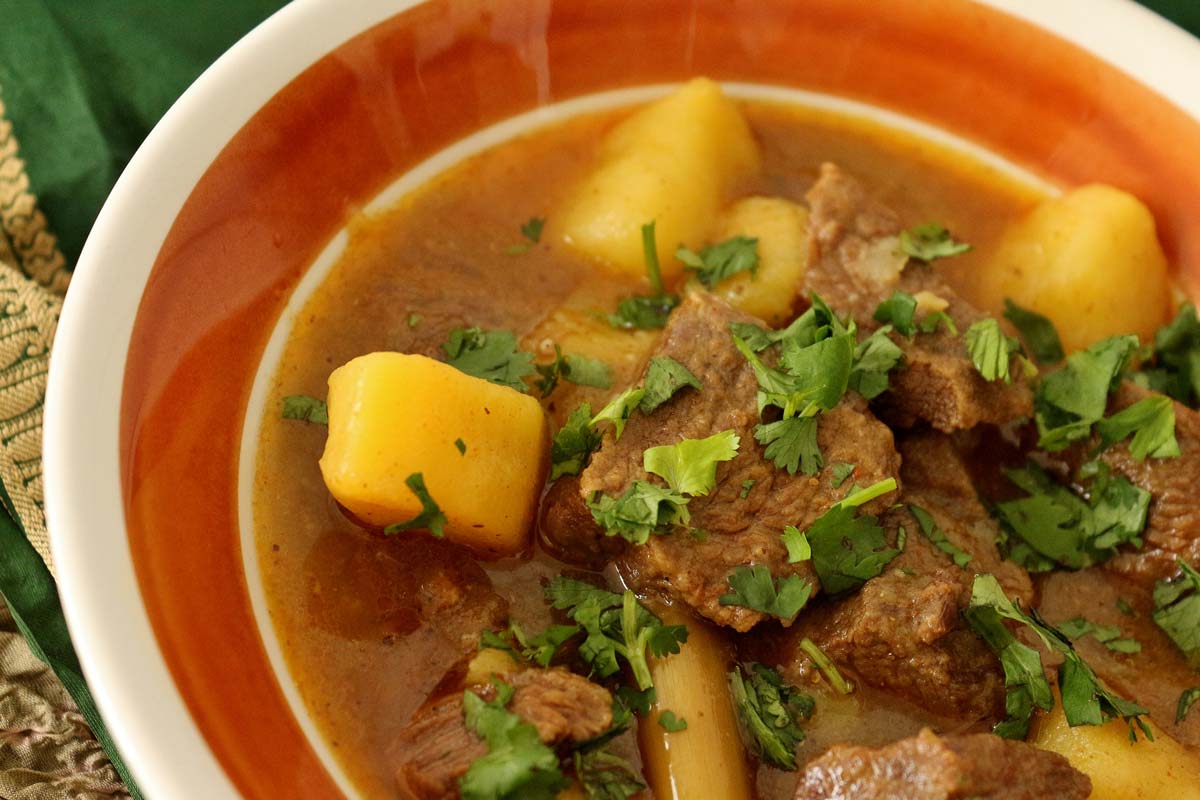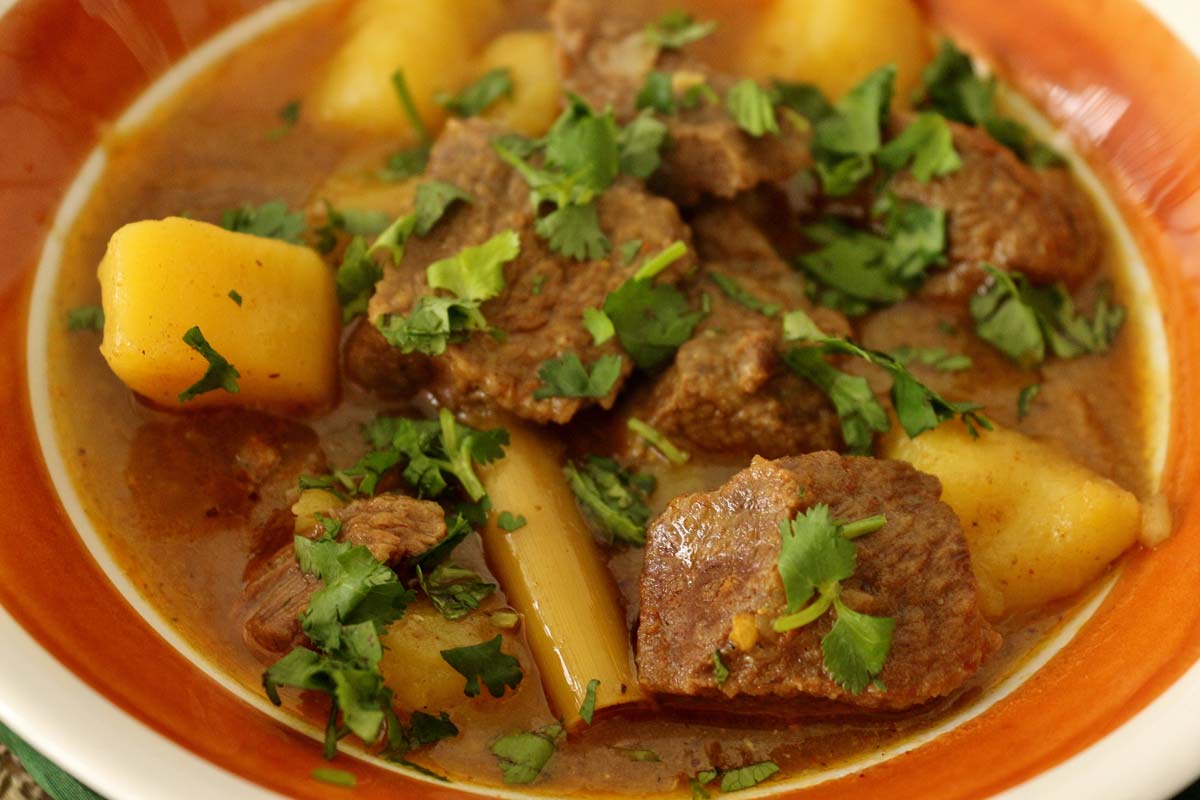This cozy and comforting Burmese curry recipe hails from Burma Superstar restaurant in San Francisco. Chunks of beef are slow-cooked in a myriad of spices before finishing with hearty potatoes, and fresh cilantro.

The Burma Superstar cookbook not only shares a look into the food and culture of Burma, renamed Myanmar in 1989, but is a companion cookbook to the restaurant of the same name in San Francisco. It straddles the line between being an excellent source of Burmese recipes, and a book for fans to recreate their favorite dishes.
Myanmar shares borders with Thailand, Laos, China, and India. Therefore, many of its culinary influences may seem similar at times with its neighbors. This delicious Burmese beef curry is a great example of a dish from this region using overlapping ingredients shared with nearby neighbors, but featuring an excellent flavor of its own.
It's super hearty, a perfect meat-and-potatoes dish that thinks outside the box. Enjoy it in the winter when seeking a cozy bowl of comfort, or anytime you're craving delicious Southeast Asian flavors.
Ingredient notes
- Beef: Stew meat is a general term for different cuts of beef that are good for stewing. You can often even purchase "stew beef" in supermarkets. If you want to cut your beef cubes from a larger cut of meat, you can try chuck or round because both are good for slow-cooked dishes. You may also replace the beef with lamb if you desire to make lamb curry.
- Madras Curry Powder: Curry powder is actually a blend of spices. The exact recipe for each blend varies depending on many factors. This Burmese beef curry uses Madras curry powder, which is a fairly spicy blend. You could use another variety if that's all you have, but the flavor and spiciness may be slightly different.
- Garam Masala: This is also a spice blend. You can make it yourself or purchase a bottle of garam masala in the spice aisle of well-stocked supermarkets and online.
- Lemongrass: Lemongrass comes in stalks, and features a lemony scent and flavor. It’s common these days at many supermarkets, and is found with the other fresh herbs. It also freezes really well, so if you buy more than you need just toss the excess in a freezer bag for next time.
- Fish Sauce: This is very common in several different Southeast Asian cuisines including Thai and Vietnamese. Fish sauce is made with anchovies and salt, and although its odor is very strong, the flavor is key to many Southeast Asian dishes.
- Thai Bird’s Eye Chile: These small, spicy Thai chiles are about 10 times hotter than a jalapeño but half the heat of a habanero, and are usually 1 to 1 ½-inches in length and either red or green. I’ve found frozen bird's eye chiles at my local Asian market. Many well-stocked supermarkets will also carry them fresh. Be sure to wear food safe gloves before handling these chiles.

How to make it
Begin by marinating cubed stew beef with paprika, turmeric, and salt.
Heat oil in a pot and add sliced ginger, cook for a few minutes, then add pieces of lemongrass and continue to cook until slightly softened. Next add sliced onions and cook for about 4 minutes before adding garlic, chiles, and bay leaves.
Lower the heat and cook for about 10 minutes until the onions have softened and much of the moisture has cooked out. Add the marinated beef and fish sauce, stirring well to combine.

Pour in water, increase the heat, bring to a boil, then lower the heat. Simmer for about 1 ½ hours, or until the meat is beginning to get tender. Stir in Madras curry powder, garam masala, and cubed potatoes. Pour in more water if the curry looks thick. Cook until the potatoes are tender, about 20 minutes more.
Ideally, let the Burmese curry sit for at least 20 minutes before serving to allow the beef to soak in the curry flavor as it cools. Bring to a simmer before serving, and taste, adding more salt or fish sauce if desired. Stir in yogurt, if using. Serve with bowls of cilantro and lime wedges at the table.
Please scroll to the bottom of the post for the full recipe (in a printable recipe card) including ingredient amounts and detailed instructions.

Expert tips
This Burmese beef curry has a stew-like consistency, and is not nearly as thick as some other styles of curry (like Indian curries for example). The term "until thickened" in the recipe is relative depending on the curry style, which in this case is much like a stew.
Although the recipe doesn't specifically say to pick out the lemongrass, bay leaves, and sliced ginger at the end of the cooking process to discard them, they shouldn't be eaten. Diners can discard them from their individual bowls of Burmese curry, or the chef can go through and remove them before serving. The former is probably more typical where each person picks them out as they go, but do whatever works for you.

Other recipes you may like
- Home-style Chicken Kebat
- Ram-Don from Parasite (Jjapaguri with Steak)
- Beef Teriyaki Udon
- Japchae (Korean Sweet Potato Noodles with Meat and Vegetables)
- Beef Noodle Soup
- Loco Moco
- Giouvetsi (Greek Beef Stew and Orzo Casserole)
- Hovězí Guláš (Czech Beef Goulash)
Tried this recipe? Please leave a star ⭐️⭐️⭐️⭐️⭐️ rating in the recipe card below and/or a review in the comments section further down the page. You can also follow me on social media on Facebook, Instagram, and Pinterest!

Burmese Beef Curry with Potatoes
Ingredients
- 2 ½ pounds beef stew meat
- 1 tablespoon paprika
- ½ teaspoon ground turmeric
- 2 teaspoons salt
- 2 to 4 tablespoons canola, vegetable, or other neutral-flavored oil (start with less and add more if needed)
- 1 ounce fresh ginger, peeled and thickly sliced lengthwise into slabs
- 2 stalks lemongrass, cut into 2-inch pieces
- 2 ½ cups finely diced yellow or red onion
- ⅓ cup minced garlic
- 1 to 3 thinly sliced Thai chiles or 2 small dried chiles (use 1 for a slightly milder curry--3 will be quite spicy)
- 2 bay leaves
- 2 tablespoons fish sauce
- 4 cups water
- 1 tablespoon Madras curry powder
- ¾ teaspoon garam masala
- 1 pound Yukon gold potatoes (about 4), peeled and cubed
- Spoonful of plain whole milk or Greek yogurt (optional)
- 1 cup cilantro sprigs, for garnish
- 1 lime or lemon, cut into wedges, for garnish
Instructions
- Trim away the sinew from the beef and cut the meat into ½-to-1-inch cubes. Transfer to a bowl and use your hands to mix with the paprika, turmeric, and salt. Let the beef marinate at room temperature while you prepare the other ingredients, or refrigerate overnight.
- In a 6-quart pot, heat the oil over medium-high heat. Add the ginger and cook until the edges become slightly browned, 2 minutes. Stir in the lemongrass and cook until slightly softened, 2 minutes.
- Add the onions, lower the heat to medium, and cook for 4 minutes, stirring often to keep the onions from sticking to the bottom of the pot. Stir in the garlic, chiles, and bay leaves. Decrease the heat to medium-low and cook, stirring often, until most of the water from the onions has been cooked out, about 10 minutes.
- Add the beef and fish sauce and stir to coat. Pour in the water. Increase the heat, bring to a boil, then lower to a gentle simmer (at this point I highly suggest taking a few minutes to skim the impurities and some of the excess oil from the surface–there was a lot of scum on mine). Cook, stirring occasionally, until the meat is beginning to become tender, about 1 ½ hours.
- Stir in the curry powder, garam masala, and potatoes. Pour in more water if the curry looks thick. Cook until the potatoes are tender, about 20 minutes more.
- Ideally, let the curry sit for at least 20 minutes before serving to allow the beef to soak in the curry flavor as it cools. Bring to a simmer before serving, and taste, adding more salt or fish sauce if desired. Stir in the yogurt. Serve with bowls of cilantro and lime wedges at the table.
Notes
- You may swap out the beef for lamb if you prefer to make a lamb curry instead.
- Although the recipe doesn't specifically say to pick out the lemongrass, bay leaves, and sliced ginger at the end of the cooking process to discard them, they shouldn't be eaten. Diners can discard them from their individual bowls, or the chef can go through and remove them before serving. The former is probably more typical where each person picks them out as they go, but do whatever works for you.
- Adapted from Burma Superstar
Nutrition
*All nutritional information is based on third-party calculations and should be considered estimates. Actual nutritional content will vary with brands used, measuring methods, portion sizes and more.*








Rahwa says
Just made this absolutely delicious warmed me right up!! Highly recommend! I made it with only curry powder since i didnt have garam masala or madras curry powder on hand. Tasted really good! Once i get those spices I’ll retry the dish and compare. I added a little bebere (ethiopian side of me) for an extra kick!
AJ says
You know Callie - well she has raved on multiple different occasions about their tea leaf salad. She’s also a huge fan of the samusa soup.
Victoria says
Excellent! I will have to try those recipes soon 🙂
Lucy Reinbold says
Yum! I can't wait to make this! Especially in the middle of winter!
Mary Kabakian says
What a perfect dish for winter. It's so tasty and easy to make.
EA The Spicy RD says
What an amazing combination of flavors! We're getting ready for rain here in San Diego, so this looks perfect for dinner tonight!
Emily Liao says
This curry is so delicious and easy to make! I made it this past week and have been enjoying it for a few days now 🙂
Alina | Cooking Journey Blog says
This is a perfect season for a flavorful stews and soups. I need to try your burma curry, I can imagine by the ingredient list how delicious and full of tami it is!
Anita says
Such an awesome and easy curry for cold winter days. First time trying Burmese food, and I'm in love! 🙂
Jenn says
This stew warmed me right up! So easy and so delicious - it's a fabulous curry!
Jen says
Today is rainy and yucky and this is exactly what I needed for dinner. So flavorful and delicious!
Camille says
What an awesome winter stew! Perfect for a cold day!